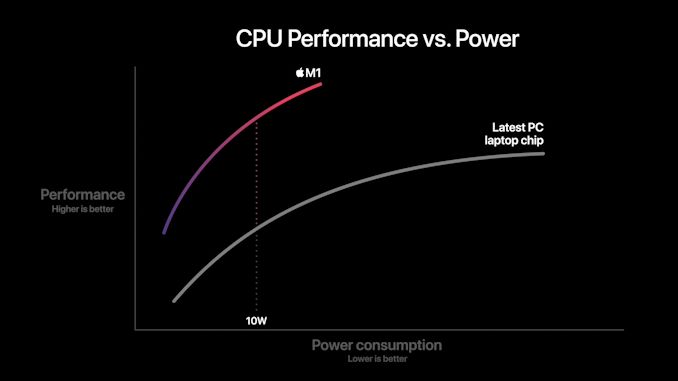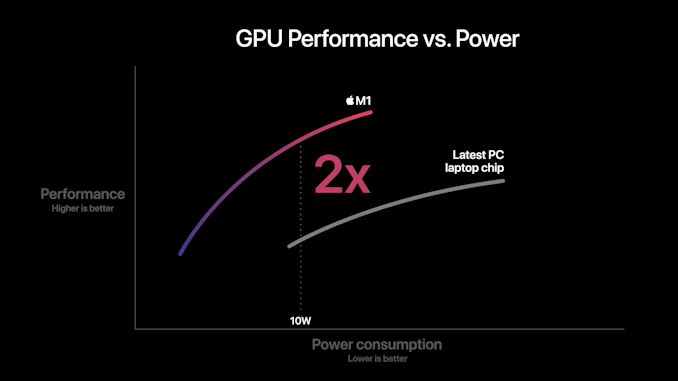Apple Announces The Apple Silicon M1: Ditching x86 - What to Expect, Based on A14
by Andrei Frumusanu on November 10, 2020 3:00 PM EST- Posted in
- Apple
- Apple A14
- Apple Silicon
- Apple M1
Apple Shooting for the Stars: x86 Incumbents Beware
The previous pages were written ahead of Apple officially announcing the new M1 chip. We already saw the A14 performing outstandingly and outperforming the best that Intel has to offer. The new M1 should perform notably above that.
We come back to a few of Apple’s slides during the presentations as to what to expect in terms of performance and efficiency. Particularly the performance/power curves are the most detail that Apple is sharing at this moment in time:
In this graphic, Apple showcases the new M1 chip featuring a CPU power consumption peak of around 18W. The competing PC laptop chip here is peaking at the 35-40W range so certainly these are not single-threaded performance figures, but rather whole-chip multi-threaded performance. We don’t know if this is comparing M1 to an AMD Renoir chip or an Intel ICL or TGL chip, but in both cases the same general verdict applies:
Apple’s usage of a significantly more advanced microarchitecture that offers significant IPC, enabling high performance at low core clocks, allows for significant power efficiency gains versus the incumbent x86 players. The graphic shows that at peak-to-peak, M1 offers around a 40% performance uplift compared to the existing competitive offering, all whilst doing it at 40% of the power consumption.
Apple’s comparison of random performance points is to be criticised, however the 10W measurement point where Apple claims 2.5x the performance does make some sense, as this is the nominal TDP of the chips used in the Intel-based MacBook Air. Again, it’s thanks to the power efficiency characteristics that Apple has been able to achieve in the mobile space that the M1 is promised to showcase such large gains – it certainly matches our A14 data.
Don't forget about the GPU
Today we mostly covered the CPU side of things as that’s where the unprecedented industry shift is happening. However, we shouldn’t forget about the GPU, as the new M1 represents Apple’s first-time introduction of their custom designs into the Mac space.
Apple’s performance and power efficiency claims here are really lacking context as we have no idea what their comparison point is. I won’t try to theorise here as there’s just too many variables at play, and we don’t know enough details.
What we do know is that in the mobile space, Apple is absolutely leading the pack in terms of performance and power efficiency. The last time we tested the A12Z the design was more than able to compete and beat integrated graphics designs. But since then we’ve seen more significant jumps from both AMD and Intel.
Performance Leadership?
Apple claims the M1 to be the fastest CPU in the world. Given our data on the A14, beating all of Intel’s designs, and just falling short of AMD’s newest Zen3 chips – a higher clocked Firestorm above 3GHz, the 50% larger L2 cache, and an unleashed TDP, we can certainly believe Apple and the M1 to be able to achieve that claim.
This moment has been brewing for years now, and the new Apple Silicon is both shocking, but also very much expected. In the coming weeks we’ll be trying to get our hands on the new hardware and verify Apple’s claims.
Intel has stagnated itself out of the market, and has lost a major customer today. AMD has shown lots of progress lately, however it’ll be incredibly hard to catch up to Apple’s power efficiency. If Apple’s performance trajectory continues at this pace, the x86 performance crown might never be regained.












644 Comments
View All Comments
daveedvdv - Thursday, November 12, 2020 - link
Fun fact: One of the ways Rosetta 2 is faster than the original Rosetta (which was no slouch) is that Rosetta 2 doesn't have to do endianness transcription.dotjaz - Wednesday, November 11, 2020 - link
Several? More like one. X1 is quite close to Lightning (int) and Firestorm (fp).bobdesnos - Tuesday, November 10, 2020 - link
need 4 ys after we will seeLuminar - Wednesday, November 11, 2020 - link
X1 is probably dead in the waterSpunjji - Thursday, November 12, 2020 - link
Not really - it won't have to compete with Apple's CPU in any market besides phones, and TBH Android and iOS aren't really "competitors" in that sense.misan - Wednesday, November 11, 2020 - link
I think you are missing the point where Zen3 is consuming 4 times the power to get comparable performance. These tests re comparing a sub 5 watt phone CPU to latest and greatest of x86 desktop CPUs. I believe the ridiculousness of this situation has not properly sank in yet.vais - Wednesday, November 11, 2020 - link
I don't understand what exactly those benchmarks are testing. Even it apple's architecture is 3-4 times more efficient, such close scores are unexpected between a 5watt vs 110 watt CPUs.To me it seems this benchmark doesn't accurately represent the real world performance of the different CPUs.
Coldfriction - Wednesday, November 11, 2020 - link
My opinion is that using dedicated silicon for a specific task and not generic CPU computing is where almost ALL of the improved performance comes from. Apple is including a lot of dedicated silicon that isn't just general computing. A Zen 3 Ryzen has some of that, but most of it is general computing. Programmable silicon will never be as fast as dedicated silicon. The M1 will look great for very specific things, and admittedly they'll be the very specific things that Apple users use the most, so it's likely a win for them. The technological claims however are bogus. Like you said, there's essentially no way that Apple made a general computing CPU that is faster than Intel or AMD; it's all the dedicated silicon.michael2k - Wednesday, November 11, 2020 - link
Like you said, there's essentially no way that Apple made a general computing CPU that is faster than Intel or AMD; it's all the dedicated silicon.It’s like you didn’t read this article or any other Anandtech article on Apple’ A series CPUs. It’s got an 8 wide cpu design; wider than Intel or AMD, it’s got 12MB L2 cache, and a much larger reorder buffer. It’s also got 8 cores, larger than Intel’s default 4 or 6, even if half of them are the efficiency cores.
Coldfriction - Wednesday, November 11, 2020 - link
No doubt what they have is efficient. But their claims are out of this world high. If it was simply a matter of making a wider CPU design, AMD or Intel would have done exactly that years ago. If it were simply a matter of making a larger L2 cache, AMD or Intel would have done that years ago.The claims are extraordinary, very extraordinary. Extraordinary claims need extraordinary evidence. Apple didn't provide that. We have yet to see any real details and this article is very very specific using a very small scale test.
CPU design is somewhat of a solved art these days. When you normalize things a specific way, it looks like things are better than they are in absolute terms. I've no doubt Apple has the best performing CPU cores for the power, but that isn't in absolute terms.
What this article needs to emphasize is that custom built silicon ALWAYS punches above its weight and performs better than generic computing devices EVER will. I watched the M1 presentation. The games looked anemic and low FPS. That's not 3X more powerful or whatever they were claiming. I want absolute performance, not normalized against specific metric performance. I also want full compatibility and not a locked ecosystem. I'll never buy a locked down Apple product like this because of the cage it would put me in.